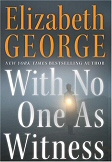

|
|
Elizabeth George delights in the variety of the English landscape, and researches scrupulously in order to give verisimilitude to her settings. Her last mystery novel is set primarily on the Island of Guernsey, a timely choice with the 60th anniversary of the second World War just passed, and the anniversary of the liberation of Auschwitz this year reminding us of the very real horrors of Nazi occupation. Guernsey was an occupied island, the possible model for the TV mini series Island At War screened last year (2004), and she refers to incidents very similar to those portrayed. Anyone who watched the drama will have a good sense of the kind of landscape and atmosphere that pertains on an island much smaller than our own, and of the tensions and resentments that the occupation will have left as a legacy.
The search for and recovery of the painting is closely linked to the search for the murderer, and ties many of the strands of the story together. It also serves to reveal character, frequently at odds with both public persona and self-image, and precipitates the very exciting climactic event in the narrative. George's ability to write a gripping story from a number of points of view is a tribute to her powers of characterisation and narration. There is no explicit sex, no gratuitous violence, but there is evocation of place and person that gives her novels the special quality that makes the reader wish they would not end - despite the fact that ending is necessary to resolve the mystery. However, there is one element in this novel that troubled me. The painting in question is of a saint seated before the building site of a Christian place of worship. Although not Jewish myself, I lived in a Jewish community for many years, and I found it hard to accept that a Jewish family would have such a painting in their home, hung over their dining table as a guest, almost, at the ceremonial seder. Ruth and Guy Brouard regard the lost painting as an heirloom of great sentimental value, the value being secondary. I consulted with several Jewish people, and to my surprise did not get a consensus on this issue. Some agreed that they would be most uncomfortable to have such a picture hung in their homes, and would never choose to do so. The Jewish religion does not acknowledge Christ, and its long history of persecution by Christian regimes does not suggest any kind of fondness or enjoyment of Christian religious scenes even on aesthetic grounds. However others felt that secular, or non-religious Jews might well keep such a painting for its aesthetic or financial worth. This ambivalence provoked me to undertake further research, and I turned - as one does, but appropriately in this case, because I could test the probability of Guy Brouard's search throwing up the favourable result he achieved - to the Internet. I discovered that a number of art works with Christian religious themes were seized from Jewish owners during the war. Most, it is true, were in collections, and one might reasonably suppose that other considerations than the faith of the collector would inform the choice of items. A few did seem to belong to ordinary householders, although this could never be taken for granted. I also discovered that reputable museums and art galleries throughout the world are involved in efforts to restore art works to their rightful owners, and that there are a number of websites containing databases of art plundered during the war, and indeed lost or stolen under any circumstances. This was confirmatory evidence on two levels: the fictional search for the painting was clearly possible, and Elizabeth George had made sure that it was. It was gratifying to find that Elizabeth George had been thorough, as usual, much as my own instincts told me that I would have used a different subject for my fictional painting had I been writing the novel. Once in research-mode, I embarked on a journey through Guernsey, checking on George's topography and geography. Here I was obliged to visit the library, Internet maps not being detailed enough. Once again, gratification ensued. I was able to locate the valleys, streets, churches and monuments she described. I envisaged popping over to Guernsey to embark on a tour along the lines of the Dickensian tours of London - or should that be tours of Dickensian London? There is something paradoxically satisfying in discovering that a story has a real and observable setting on one or more levels. The intersection of fact and fiction makes both more interesting. Perhaps it places a limit on the suspension of disbelief, giving it an acceptable, or achievable dimension. Suspension of disbelief to some extent is always part of the contract between reader and writer. George's extensive research, her carefully accurate rendering of both modern setting and historic event, even her punctilious advancement of the lives of her familiar characters, make it unlikely that she would succumb to a jarring anomaly. It is perhaps chief among the attractions that her narratives offer: the realism that attracted us as children when jolly adventure stories suggested that we too could embark on an exciting romp. We do not couch our response in these terms, perhaps, but the realism of a novel like A Place of Hiding gives us an opportunity to do what I have done - to research, to verify, to recognise perhaps, perhaps to learn. It holds out the possibility that the enchanted land is accessible, and the role of hero available to us all. |
|
|
Read SHOTS’ review of A PLACE OF HIDING
|
|

|
Elizabeth George’s latest novel from Hodder & Stoughton is With No One As Witness. Click here for more information http://www.elizabethgeorgeonline.com/novel-withnooneaswitness.htm |
|
Useful websites: |
|

| Webmaster: Tony 'Grog' Roberts [Contact] |